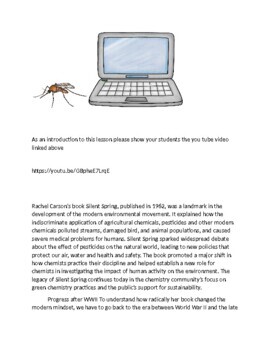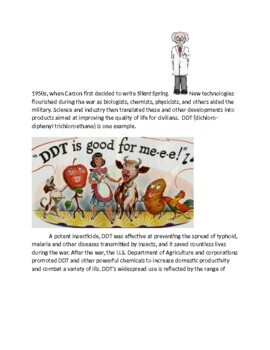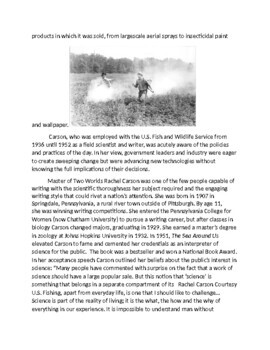Silent Spring by Rachel Carson High school biology, chemistry, history lesson
- Word Document File
- Internet Activities
Description
The activities are designed as a ready-to-go lesson, easily implemented by a teacher or his/her substitute to supplement a unit of study. In chemistry, the activities relate to concentration, with units as small as parts per million; solubility of compounds in water versus fat; and decision-making based on green chemistry principles. In biology, the activities related to the effect of a contaminant on a food chain and bioaccumulation of a fat-soluble contaminant. In environmental science, the activities highlight the weighing of benefits versus drawbacks in the use of a material or technology and the effect of Silent Spring on our views of humans and nature.
History Exercise: Chronology of Carson's Work and DDT Using the handout, students place events from Carson’s life in chronological order on a timeline. They then add marks to the timeline to indicate key events in DDT discovery and use, to illustrate how the main part of Carson’s career aligns with the rise and fall of DDT. They also discuss how Carson’s background made her well suited to present in-depth scientific information to the general public through work like Silent Spring.. (10-20 min.)
Science, Society and Silent Spring Students recognize that different groups of people can have different reactions toward a scientific work. They also note the different types of information and sources that Carson included in her rigorously researched work and discuss the book’s lasting effects.. (15-20 min.)
Science and Decision-Making Students realize that the use of any material or technology has both benefits and drawbacks, and that considering whether the positives of their use outweigh the negatives can be complex. They identify specific drawbacks related to DDT’s benefits, devise arguments both in support of and against an idea, and consider additional information that would be needed to make a decision in a green chemistry scenario. (20-25 min.)
Concentration and Solubility Students explore the concepts of concentration of a solution and the ability of a solute to dissolve in water versus fat. They picture an imagined dilution of food coloring to help grasp the idea of small concentrations such as one part per million. They also predict the effects that ingesting fat-soluble DDT can have on organisms in a marsh food chain. (15-20 min.)





